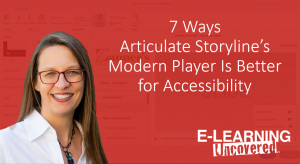Articulate Storyline 360: The Year in Review 2020
2020 was quite a year!! In the midst of all the crazy, were you able to stay on top of all the great new features Articulate released over the course of the year? Enjoy this recording from our Jan 2021 webinar where we highlighted some of the best new features of the year—features that can make your courses more robust, more accessible, and more efficient to build.
Want to try these new features for yourself? Use the button below to download the practice files used in this webinar.


Learn To Master Storyline Variables
Learn more about our on-demand course “Mastering Variables in Articulate Storyline” and take advantage of special pricing.

 Previous Post
Previous Post Next Post
Next Post




Hi William,
Thanks for sharing the Storyline Year in Review webinar. It’s very informative and useful. I just wanted to point out that how you map styles to HTML headings and other structural elements is quite important from an accessibility point of view in particular. Specifically, if you map to an “h1” element, then that element should be the main heading for the page with regards to the semantic structure of information in the page – see https://webaim.org/techniques/semanticstructure/ . In other words, you shouldn’t assign an “h1” element stylistically – simply because you want to make the text big. Users who use screen readers will become confused because they rely on the semantic structure of headings within a document and often navigate from one heading to another using their screen reader.
Excellent point, William! Fortunately, you can create unlimited new styles using the “p” paragraph tag when you want to control the look of text but don’t want to assign it to a specific part of the hierarchy.